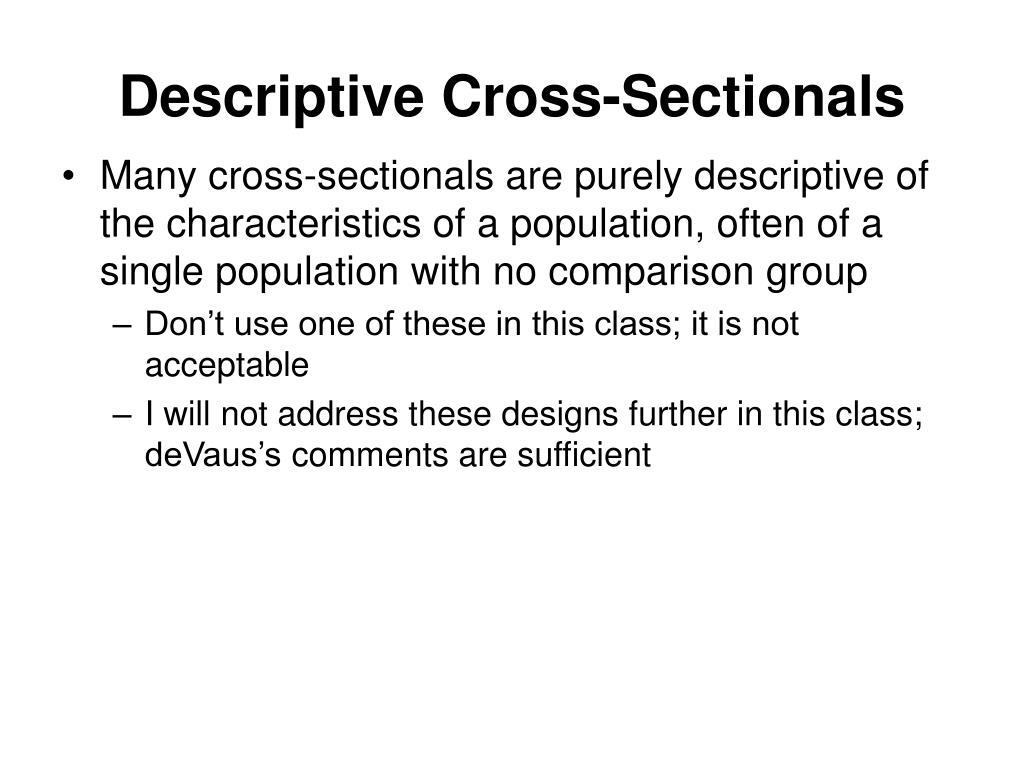Table Of Content
- What is a cross-sectional study?
- Selecting Your Sample Population for your cross-sectional surveys
- Study population
- Publication types
- The mediating effect of flow on the relationship between simulation design and simulation educational satisfaction
- Add to Collections
- It cannot be used to analyze behavior over a period of time

With a single cross-sectional survey, you can gather comprehensive information about your customers' characteristics, the types of sports that they like to play and watch, and their reactions to some of your current product offerings. One of the major uses of cross-sectional research is to assess the traits or qualities of a specified population. For that reason, these studies often gather multiple pieces of demographic data or other data that will enable you to draw up a picture of your target population.

What is a cross-sectional study?
Providing students with resources and skills to cope with academic stress can improve their well-being and academic performance. Educators can incorporate teaching strategies that promote deep learning approaches, such as problem-based learning, critical thinking exercises, and active learning methods. These approaches help students engage more deeply with course material and reduce reliance on surface learning techniques. Recognizing the gender differences in learning approaches, nursing programs can offer gender-specific support services and resources. For example, providing targeted workshops or counseling services that address male and female nursing students’ unique stressors and learning needs. Implementing mentorship programs and peer support groups can create a supportive environment where students can share experiences, seek advice, and receive encouragement from their peers and faculty members.
Selecting Your Sample Population for your cross-sectional surveys
The data were collected by interviewer-administered questionnaires (for sociodemographic and behavior data), clinical evaluation for sexually transmitted infections (STIs), and serological evaluation for STIs (including HIV). As discussed in the earlier articles, we have highlighted that in an observational study, the investigator does not alter the exposure status. The investigator measures the outcome and the exposure(s) in the population, and may study their association. Confidence intervals (CI) measure the precision of the OR, RR, or the possible “variation in a point estimate (the mean value)” (Alexander, 2015b, p 4).
Study population
This adjustment allocated the weights of nonrespondents (category 2) to those of respondents (category 1) within classes defined by the cross-classification of sampling strata, census region, and sample type (e.g., ABS and list supplemental samples). Those classes with fewer than 50 sampled addresses or large adjustment factors were collapsed with nearby cells within the sample type. Given the large variance in the household weights among the medium density ABS stratum, final household weights for addresses within this stratum were capped at 300.
Mix some yes-or-no questions with others that let people give more detailed answers. In these isolates, resistance for erythromycin, clindamycin, and azithromycin was observed in 98%, 90%, and 100% of the isolates, respectively. However, sensitivity for tetracycline, doxycycline, minocycline, and levofloxacin was observed in 69%, 56%, 98%, and 90% of the isolates, respectively.
Cardiovascular disease behavioural risk factors in rural interventions: cross-sectional study Scientific Reports - Nature.com
Cardiovascular disease behavioural risk factors in rural interventions: cross-sectional study Scientific Reports.
Posted: Thu, 17 Aug 2023 07:00:00 GMT [source]
Publication types
Hospital/ward/patient-level data was collected in June 2022 using standardized GPPS patient and ward forms (see in the appendix). The ward form extracted denominator data which comprised all inpatients present in the specific ward before 8 A.M. The patient form captured the numerator data of all admitted inpatients receiving an “active/ongoing” antimicrobial prescription at 8 A.M on the day of the GPPS. Data extracted include details on antimicrobial agents, indications, diagnosis and a set of quality indicators such as stop/review date and compliance to the guidelines. Data was de-identified during extraction and uploaded in specific portal for analysis at Antwerp University (AU) in Belgium.
Extended postpartum intimate partner violence and its associated factors: community-based cross-sectional study ... - BioMed Central
Extended postpartum intimate partner violence and its associated factors: community-based cross-sectional study ....
Posted: Wed, 20 Sep 2023 07:00:00 GMT [source]
They were also assessed by a five-person jury of professionals from the education and psychiatric nursing departments. The scales were found to have sufficiently evaluated the intended structures by the jury. Strategies addressing stressors and promoting healthy learning approaches are essential for enhancing nursing education and student well-being. A cross sectional study conducted among households in densely populated townships in Malawi revealed high usage of antibiotics such as Amoxicillin, Erythromycin and Cotrimoxazole [12].
This means that researchers do not manipulate variables, and they don’t assign different cohorts in a sample to different study groups. Instead, the researcher simply records the information they observe within a population. Cross-sectional studies can also be susceptible to confounding, where an external variable influences both the independent and dependent variables, creating a spurious association. Without longitudinal data, it is difficult to control for or identify these confounding factors, which can lead to erroneous conclusions. Researchers must carefully consider potential confounders and employ statistical methods to adjust for these variables where possible. The versatility of cross-sectional studies is evident in their wide applicability across various fields and purposes.
Did the participant become obese due to sedentary behavior, or was the participant inactive due to obesity? According to Cummings et al., 2013, determining which variable to label as dependent or independent “depends on the cause-and-effect hypotheses of the investigator” (p. 85) or the biological plausibility rather than on the study design. The similarity in the ranking of simulation design sub-factor scores in this study and previous studies suggests that efforts are needed to strengthen the simulation design capabilities of Korean nurse educators. To increase fidelity, simulation technology support should be provided at the school level. In addition, since simulation is a recently utilized teaching method in Korean nursing education, most nurse educators lack experience in simulation education.
As cross-sectional studies are cheaper and less time-consuming than many other types of study, they allow you to easily collect data that can be used as a basis for further research. A cross-sectional study is a cheap and easy way to gather initial data and identify correlations that can then be investigated further in a longitudinal study. Longitudinal studies require more time and resources and can be less valid as participants might quit the study before the data has been fully collected. Cross-sectional studies can be categorized based on the nature of the data collection and the type of data being sought. Typically, these studies are used to measure the prevalence of health outcomes and describe the characteristics of a population. You need to have completed thestructural design for the house, that is, determined the required sizeand location of all structural walls, posts and beams.
The survey also asked respondents how many adults ages 18 or older live in their household including themselves, from one to 10 adults. Additionally, the survey asked how many children under 18 live in their household, from zero to 10 children. Asian adults were categorized as “living near or below the poverty line” if their approximate family income, after being adjusted for family size, falls at or below 100% of the 2022 federal poverty line. All Asian adults who meet the criteria above are used for the analysis of Asians in poverty, irrespective of their status as students or not. Those excluded were people solely of Southwest Asian descent (e.g., Lebanese, Saudi), those with Central Asian origins (e.g., Afghan, Uzbek) as well as various other non-Asian origins. The impact of excluding these groups is small, as together they represent about 1%-2% of the national U.S.
Cross-sectional studies do not manipulate variables and, therefore, cannot determine cause-and-effect relationships. However, cross-sectional studies can offer valuable insights into a population and lay the foundations for future research using experimental or longitudinal studies. A cross-sectional study involves gathering and analyzing data from a population of interest at one specific point in time. Typically, the researcher is conducting the study to describe the characteristics of the population, or to explain the relationship between a particular outcome and some other variable(s) of interest.
Below, we explore three significant benefits of employing cross-sectional studies in research endeavors. An example might be exploring the usage patterns of a new technology within a population to identify trends and areas for in-depth study. They can’t tell you what causes something, and sometimes the results might be skewed by how the questions are asked or who answers them. As you embark on designing and implementing your cross-sectional survey, consider leveraging the power of resonio.

No comments:
Post a Comment